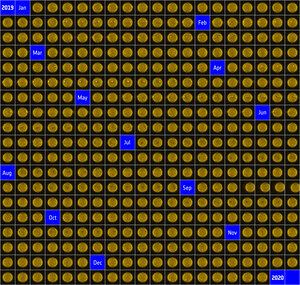

Ten Suns for 10 years
Last week marked a milestone for ESA’s Proba-2 satellite: 10 years of operation in orbit around the Earth. Since its launch on 2 November 2009, Proba-2 (PRoject for OnBoard Autonomy) has probed the intricacies of the Sun and its connection to our planet, imaging and observing our star and investigating how it drives all manner of complex cosmic phenomena: from solar eruptions and flares to closer-to-home space weather effects.
This image shows 10 different views of the Sun captured throughout Proba-2’s lifetime, processed to highlight the extended solar atmosphere – the part of the atmosphere that is visible around the main circular disc of the star.
Characterising this part of the Sun is a key element of Proba-2’s solar science observations. Solar activity is closely tied to the space weather we experience closer to Earth. Understanding more about how the Sun behaves – and how this behaviour changes over time, including whether it may be predictable – is crucial in our efforts to prepare for space weather events capable of damaging both space-based and terrestrial communications systems.
The Sun’s activity has a cycle of about 11 years, with the presence and strength of phenomena such as flares, coronal mass ejections, dark ‘coronal holes’ and bright ‘active regions’ fluctuating accordingly. These images were taken by Proba-2’s extreme-ultraviolet SWAP (Sun watcher using APS detectors and image processing) instrument, and show a snapshot of the Sun in January or February of each year from 2010 to 2019 (with the oldest frame on the top left, and the most recent to the bottom right). This mosaic thus neatly shows the variability in the solar atmosphere in beautiful detail, demonstrating how this cycle affects the Sun. The Sun begins in a phase of low activity (solar minimum: top left) in 2010; enters a phase of increasing activity and then shows highest activity in 2014 (solar maximum: top right). It slowly calms down again to enter a low-activity phase in 2019 (another minimum: bottom right).
As its name suggests, Proba-2 is the second satellite launched under ESA’s ‘Project for Onboard Autonomy’ umbrella: a series of small, low-cost missions that are testing a wide array of advanced technologies in space. These missions are helping us understand and develop everything from solar monitoring to vegetation mapping to autonomous Earth observation. Future members of the Proba family will also be equipped to create artificial eclipses by flying two satellites together in formation to block the bright disc of the Sun for hours at a time, so that scientists can better observe fainter regions that are usually outshone.
For now, Proba-2 will continue to monitor the Sun, including an upcoming celestial event: the satellite’s SWAP camera will observe Mercury today as it transits across the face of the Sun, an event that only takes place around 13 times per century and will not occur again until 2032.
The individual frames of the image shown here were captured on (top row, left to right): 20 February 2010, 1 February 2011, 20 January 2020, 5 February 2013, 28 January 2014, and (bottom row, left to right) 19 January 2015, 5 February 2016, 22 January 2017, 2 February 2018, and 1 February 2019.





